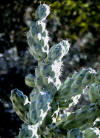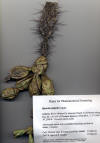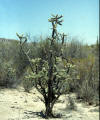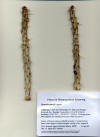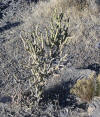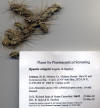| Photos are arranged
alphabetically by species name in the genus Opuntia,
now generally recognized to be polyphyletic.
Delimitation of the opuntioid genera remain controversial, however.
Among the examples shown below, Grusonia had been
distinguished by the caespitose habit with clavate segments and by its flattened spines.
This is in contrast
to rounded spines in Cylindropuntia that is easily recognized by
the
more upright cylindrical stems as implicated in the genus name, and in
further contrast to the flattened stems of Opuntia. (Pinkava 2003; Rebman 2006;
see also Taylor et al;. 2002; Stuppy 2002).
However, Griffith (2002) proposed further splitting, supported by molecular data;
for example, Grusonia robertsii Rebman (2006), a recently described
species from Baja California, was transferred to Corynopuntia (Bulot
& Solichon 2009). What has been generally regarded as Grusonia
becomes Corynopuntia; Grusonia is then limited to the type,
G. bradtiana, a species occurring in Coahuila, Mexico; it is mat forming, to 1 m
high, with short teretiform ribbed segments, without glochids except flowering
segments, and with fleshy fruits in contrast to dry fruits of Corynopuntia
(Griffith 2002; Stuppy 2002).
|
||
|
Cylindropuntia (Opuntia)
acanthocarpa
|
Corynopuntia (Opunta) aggeria
|
Cylindropuntia arbuscula |
|
Opuntia basilaris |
Opuntia basilaris |
Opuntia basilaris
|
|
Cylindropuntia (Opuntia) bigelovii
|
Cylindropuntia
(Opuntia) californica
var. rosarica |
Cylindopuntia echinocarpa |
|
Opuntia phaecantha
|
Opuntia cholla |
Cylindopuntia (Opuntia)
echinocarpa
|
|
Cylindopuntia (Opuntia)
echinocarpa
|
Cylindropuntia (Opuntia) fulgida
|
Cylindropuntia (Opuntia) fulgida
|
|
Cylindopuntia (Opuntia) munzii BCN: Vicinity of El Arco, May 1996. This collection site extends the known distribution for C. munzii from northern BCN to near the state line of Baja California Sur in Mexico. This species, which reportedly flowers in May, is generally known from spotty occurrences much further north—in the Chocolate and Chuckwalla Mountains of California—and in the San Felipe desert of Baja California Norte—ranging in elevation from 400 to 2,000 ft. It also has been regarded as a hybrid between C. acanthocarpa and C. bigelovii; however, it can be found with Colubrina californica (which its habit near the El Arco site is a large tree in contrast to a shrubby habit in California and Arizona), another relatively uncommon species with disjunct occurrences in Baja California, California and Arizona. This distribution pattern, along with its association with C. californica, suggests that Opuntia munzii is a relict species rather than a rare hybrid. It reportedly flowers in May.
|
||
|
Corynopuntia (Opuntia) invicta
|
Cylindropuntia (Opuntia)
leptocaulis |
Corynopuntia
(Opuntia) parishii
|
|
Cylindropuntia (Opuntia) parryi
|
Big Bend National Park, TX;
Spjut & Marin 14467 |
Opuntia polyacantha
var. erinacea
|
|
Opuntia polyacantha
var. erinacea
|
Cylindopuntia (Opuntia)
molesta |
Opuntia pycnantha
|
|
Opuntia
aff. pycnantha
|
Cylindropuntia (Opuntia) ramosissima
|
Cylindropuntia (Opuntia) whipplei
|
|
Trees and Shrubs of Kern County (Jan 2013) Cylindropuntia. Authorities differ in opinion as to which Cactaceae are considered shrubs. They are all perennial, but only Cylindropuntia develops a woody stem, mostly for a short distance above the base of the plant; roots are not woody. Key to Cylindropuntia 1. Stems 0.5–1 cm thick; spines solitary........................ Cylindropuntia ramosissima 1. Stems 2–3 cm thick; spines 3–12........................................................................... 2
2. Plants more densely branched near apex than below;
2. Plants uniformly branched; tubercles 2–3 cm
Cylindropuntia acanthocarpa (Opuntia acanthocarpa Engelmann & Bigelow 1856) F.M. Knuth 1935 var. coloradensis (L.D. Benson 1969) Pinkava 1999. Colorado buckhorn cholla. Creosote scrub to Joshua tree woodland, below 4,500 ft, to Utah and Sonora, Mexico. Kern Co.: 3 mi w Inyokern - Freeman Quadrangle, 853 m, (E. Armstrong, 1 Apr 1934; CCH). Cylindropuntia echinocarpa (Opuntia echinocarpa Englemann & Bigelow 1856) F. M. Knuth 1935. Silver cholla. Creosote scrub to pinyon-juniper woodland below 6,000 ft, Mono Co to Baja California. Kern Co.: “Occasional on the high desert; uncommon west to Kernville (although the finest colony in the county grows on the4e slopes the broad mouth of Fay Canyon north of Weldon). Although cacti are often thought of as being among the most drouth [sic] resistant of plants, numerous colonies of silver cholla have died during the extended drouths of the last 20 years” (Twisselmann). Records in CCH from Short Canyon, 929–1,158 m. Cylindropuntia ramosissima (Opuntia ramosissima Englemann) F. M. Knuth 1935. Pencil cholla. [Includes Opuntia tesselata Engelmann 1856]. California to Texas, Mexico. Edwards Air Force Base (Moe). Not in CCH or Twisselmann. General References Ahmed M.S., N. D. El Tanbouly, W. T. Islam, A. A. Sleem and A. S. El Senousy. 2005. Antiinflammatory flavonoids from Opuntia dillenii (Ker-Gawl) Haw. flowers growing in Egypt. Phytother. Res. 19(9): 807–809. Bulot, L. G. and J. M. Solichon. 2009. Corynopuntia invicta. Cactus Succulentes 1: 63–65. Griffith, M. P. 2002. Grusonia pulchella classification and its impacts on the genus Grusonia: Morphological and molecular evidence. Haseltonia 9: 86–93. Moberg, S. 1984. Opuntia dermatitis--a skin reaction difficult to treat, caused by an ornamental cactus. Lakartidningen 81(13): 1311–1312. In Swedish. Phaff H. J., W. T. Starmer, M. A. Lachance and P. F. Ganter. 1994. Candida caseinolytica sp. nov., a new species of yeast occurring in necrotic tissue of Opuntia and Stenocereus species in the southwestern United States and Baja California, Mexico. Int. J. Syst. Bacteriol. 44(4): 641–645. “We describe Candida caseinolytica, a new yeast species which occurs in rotting tissues of opuntias and other cacti in the North American Sonoran Desert and a few other localities. This small-celled, slowly growing yeast does not ferment any sugar and assimilates a limited number of carbon compounds, including 2- and 5-ketogluconic acids. It exhibits strong extracellular proteolytic activity on casein at pH 6.5, but gelatin is not hydrolyzed or is only weakly hydrolyzed by a few strains. The type strain of C. caseinolytica is strain UCD-FST 83-438.3 (= ATCC 90546 = CBS 7781).” Pinkava, D. J. 2003. Opuntioideae. FNA 4: 102–150. Rebman, J. P. 2006. A new club cholla, Grusonia robertsii (Cactaceae) from Baja California Sur, Mexico. Madroño 53: 278–281. Stuppy, W. 2002. Seed characters and the generic classification of the Opuntioideae (Cactaceae). Succulent Plant Res. 6: 25–58. Taylor, N. P., W. Stuppy and W. Barthlott. 2002. Realignment and revisions of the Opuntioideae of eastern Brazila. Succulent Plant Res. 6: 99–132. Tesoriere L, M. Fazzar, M. Allegra and M. A. Livrea. 2005. Biothiols, taurine, and lipid-soluble antioxidants in the edible pulp of Sicilian cactus pear (Opuntia ficus-indica) fruits and changes of bioactive juice components upon industrial processing. J. Agric. Food Chem. 53(20): 7851–7855. “Biothiols, taurine, and flavonols, as well as tocopherols and carotenoids have been assessed in the edible pulp of Sicilian red (Sanguigna), yellow (Surfarina), and white (Muscaredda) cultivars of cactus pear. The yellow cultivar has the highest level of reduced glutathione (GSH, 8.1 +/- 0.78 mg/100 g pulp), whereas the white cultivar showed the highest amount of cysteine (1.21 +/- 0.12 mg/100 g pulp). Taurine accounted for 11.7 +/- 1.0 mg/100 g in the yellow pulp, while lower levels were measured in the others. With the exception of kaempferol in the yellow cultivar (2.7 +/- 0.2 microg/100 g pulp), the edible pulp of cactus pear was not a source of flavonols. Very low amounts of lipid-soluble antioxidant vitamins such as vitamin E and carotenoids were measured in all cultivars. As a consequence of industrial processing, a total loss of GSH and beta-carotene and a net decrease of vitamin C and cysteine were revealed in the fruit juice, whereas betalains, taurine, and vitamin E appeared to be less susceptible to degradation.” Whiting D. A. and J. H. Bristow. 1975. Dermatitis and keratoconjunctivitis caused by a prickly pear (Opuntia microdasys). S. Afr. Med. J. 49(35): 1445–1448. “Two patients were affected by the barbed bristles of the ornamental cactus Opuntia microdasys, a small prickly pear plant. Dermatitis occurred in both patients and consisted of itchy papules produced by implantation of the glochids. One patient developed a severe keratoconjunctivitis in the right eye, which cleared after a glochid had been located in the palpebral conjunctiva, and removed. The glochids were studied under light and scanning electron microscopes and their structral details are described.”
Wijeratne E.
M., T. J. Turbyville, Z. Zhang, D. Bigelow, L. S. Pierson 3rd, H. D.
VanEtten, L. Whitesell, L. M. Canfield and A. A. Gunatilaka. 2003.
Cytotoxic constituents of Aspergillus terreus from the rhizosphere
of Opuntia versicolor of the Sonoran Desert. |
||















